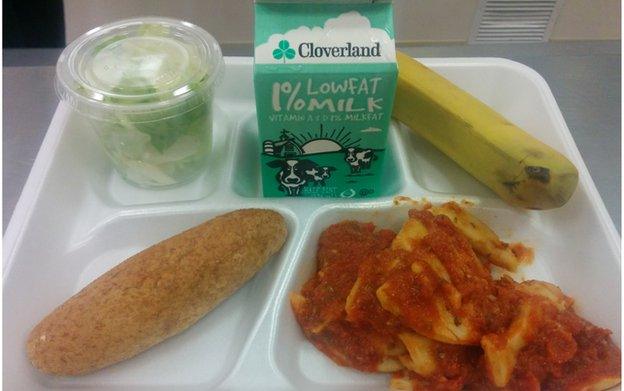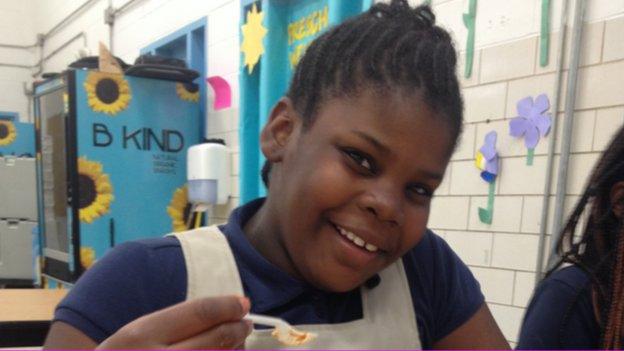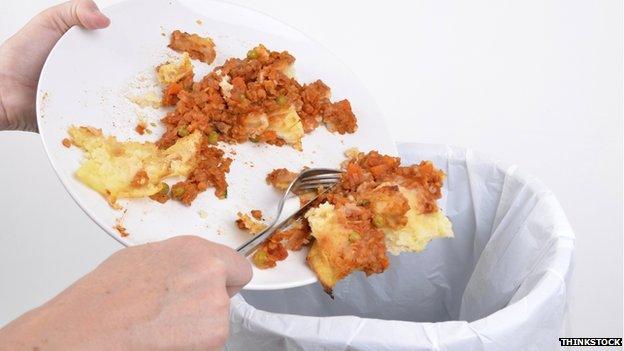Can healthy eating be forced on children?
- Published

The school lunch at Woodridge Elementary
First Lady Michelle Obama has been at the forefront of the campaign to change school meals in America and fight childhood obesity. But can you force children to eat healthily?
It's almost lunchtime in the school canteen at Friendship Woodridge Elementary School in Washington DC. Today's menu is potato ravioli, a romaine salad and whole wheat breadsticks, served with fat-free milk. For desert, a banana.
"It's a very healthy menu," says lunch lady Katrina Fitzgerald as she ladles a helping of ravioli on to a plate.
"They used to complain but they don't too much now, I think they're used to it."
The menus here have changed dramatically in recent years, since the Healthy Hunger-Free Kids Act came into law in December 2010. The law, which was championed by First Lady Michelle Obama, includes strict guidelines for school lunches.
Today, she will host winners of a healthy recipe contest at a children's dinner event at the White House.
Mrs Obama has been a vocal advocate for healthier school lunches, as part of her Let's Move campaign to reduce childhood obesity. With more than a third of children in the US overweight or obese, the focus is on ensuring good eating habits start at a young age.
These measures have been phased in gradually, but include a requirement for school meals to include fresh fruit and vegetables, as well as grains, protein and dairy. There are also strict limits on salt, sugar, fat and calorie content. Schools are given additional funding for implementing these changes.
At Woodridge, chips have been replaced with baked fries. The school changed its meal supplier and now even grows its own salad leaves.
Bags of grapes are stored in the fridge, ready to be served as the afternoon snack. Even the snack machines have gone healthy, with baked potato crisps and apple chips.

Destiny says she's gotten used to the new fare
Many of the pupils here are from low-income families where processed, unhealthier food tends to be more available.
"They weren't used to eating fruits and vegetables or salads," says school principal Richter Craig.
Newsagents and gas stations selling junk food are within easy reach of the school, making this trickier.
"It's not out of the ordinary to see a student walk into the building with pizza and a soda at eight o'clock," he says. "So we have to say, let's eat this instead."
Craig says when pupils begin to feel more energetic and awake and attentive in class, they begin to understand why these changes are necessary. It's also helping to change the mindsets of parents, he says, as students go home and talk about what they eat.
"I think it's actually good and it's healthy for me," says a student named Destiny. "Healthy food tastes good actually, but I do kind of miss the junk food, the candy and the soda the most."
One other boy agrees, but they seem to be the exceptions.
"It's nasty, but we've got to eat it because our teachers have been forcing us," says one boy, Maurice. "If we don't we have to go to the back table,"
It's not just students expressing distaste. The School Nutrition Association (SNA), which represents 55,000 school nutrition professionals across the country, has written a letter to the First Lady saying that, external while it applauds the drive for more nutritious meals, schools need more flexibility to appeal to students.
.jpg)
"Too many individual school district operations continue to struggle with the increased costs, decreased revenues, increased waste and declining participation directly associated with implementation of the nutrition standards."
The US government says that 90% of school meal programmes have met the requirements set out in the new law, but the SNA argues that doesn't mean the scheme is a success. It says the numbers of children eating lunch at school has fallen in 49 states, with one million fewer students choosing school lunches.
Some Republican politicians have been pushing for a waiver to allow schools to opt out of the strict standards, which were passed with bipartisan support.

Is it working?

School meal vegetable consumption per student increased 16% from 2011 to 2012, when the regulations went into effect
In that time, more students - 23% more - selected fruit, but fruit consumption per student remained flat.
Before 2012, students discarded 75% of the vegetables on their tray. After, that number dropped to 60%.
Both before and after the regulations, students discarded 40% of their fruit.
Source: Harvard University, external

"I've never said no to serve healthy food, but let's serve healthy food that kids are going to eat that's not leading to the exponential increase in plate waste," says Republican congressman Rodney Davis, from Illinois.
The usually apolitical first lady has hit back at Republican efforts to roll back her changes.
"The last thing we can afford to do right now is play politics with our kids' health," she said to school nutrition directors at a White House event in May.
"In 10 or 20 years, I don't want to look back with regret and think that we gave up on our kids because we felt like this thing was too hard or too expensive.."
But the challenges persist. Back at the canteen I meet Cherokee, who has brought in her own lunch, processed cheese and ham.
"It's because the school food is gross and it makes me throw up right now," she said. "I don't like their food, I don't think it's very good for me, my stomach is growling when I get to class."
The fight to reduce childhood obesity is challenging, and one which experts say needs to work in tandem with reducing portion sizes and encouraging more exercise.
But the question is whether politicians should implement more drastic measures like the First Lady's or adopt a more flexible approach.
Either way, changing tastes isn't easy.